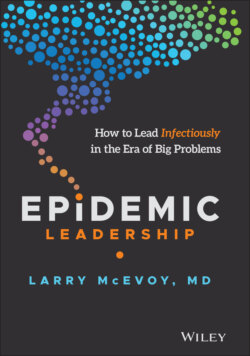Читать книгу Epidemic Leadership - Larry McEvoy - Страница 16
Negative to Positive
ОглавлениеAfter all the unwinding of what we considered stable and normal by COVID-19, the idea of emulating an epidemic, rather than fighting one, sounds almost sociopathic. Beyond understanding the dynamics of misery, is there anything to learn from these sprawling, creeping, relentless phenomena? Can understanding epidemics shed light on how we might lead positively, effectively, and exponentially in a world where disruption, velocity, and uncertainty bloom in the fields of “new normal” or the “new abnormal”? Can epidemics teach us, not just warn us? Can we learn to lead like them, not just in the face of them?
Yes.
Epidemics are not just negative and devastating; they can be positive and empowering. They surf on the same principles of social networks and multiply via the same organizing elements that leaders can use to positive advantage. What differentiates the value of an epidemic is its pathogen, its “disease maker,” the thing that is multiplied and spread across a population. While the duration of a pathogen's effects and how fast or slow it spreads are adjuncts of whether we see an epidemic as “bad” or “good,” the kernel of its value lies in its founding idea, which can unfold in unforeseeable combinations across populations. Bad ideas cause bad epidemics as they spread through our linked social networks, themselves powered by neural and technological networks; good ideas can seed good epidemics via the same approaches.
Ebola kills 50 percent, more or less, of the people who have it, and it's highly contagious, easily leaping from person to person unless you take active and repetitive precaution. Although we might consider a hypothetical disease called “Ebola lightweight” “better” if it were very difficult to pass from one person to the next and killed only 2 percent of those afflicted, the fundamental reality is that the Ebola virus is a recipe packet for human harm. On the other hand, innovation, collaboration, creativity, and empathy are action-ideas we would love to see bloom into epidemics in multiple places where they are currently missing. Although biological and behavioral epidemics are both different and similar, what differentiates bad and good is not how the epidemic organizes and moves, but what it carries. Positive epidemics carry good “pathogens,” or payloads, whereas bad epidemics carry bad ones.
As we might expect in a world filled with its share of ambiguity and trade-offs, some epidemics carry both. Malaria, for example, has the nasty effects of causing illness, organ damage, and death, but has also driven the genetic origin of a hemoglobin variant that provides resistance to malaria. That variant, in turn, carries the burden of sickle cell disease. Viruses themselves carry genes that have integrated into our own genome over generations. Some of these genes contain the coding for essentially human processes—gestation, for example.9 As we shall see, designing or selecting the right payload is critical, as is the ability to design and facilitate uptake and diffusion—spread!—constructively matched to that payload or idea.
Instead of waiting for small ideas and particles to mushroom serendipitously into big problems, would it be possible to think of large-scale positive effect and then grow it from a tiny—and accessible—idea or action into a macro effect? What if leaders could conjure positive “idea pathogens” and then support their interactive trafficking into stable and impactful patterns by tapping how epidemics originate and move?
For a moment, let's imagine the promising power of positive epidemics. Get the words “bad,” “devastating,” “death,” “disease,” and “harmful” out of your head. Let's look not at the effects epidemics wreak upon our minds and bodies and social institutions, but at the way they work, their intrinsic properties.
